A Marvel of Ancient Indian Architecture and Art
Khajuraho, a small town in Madhya Pradesh, India, is renowned for its stunning group of Hindu and Jain temples, known for their intricate and explicit erotic sculptures. These temples, built between 950 and 1050 AD by the Chandela dynasty, represent a pinnacle of Indian art and architecture. The Khajuraho Group of Monuments is a UNESCO World Heritage Site, consisting of 25 temples that remain from the original 85. The temples are divided into three groups: Western, Eastern, and Southern. The Western Group is the most famous and includes the Kandariya Mahadeva Temple, which is dedicated to Lord Shiva and features some of the most detailed carvings. The Eastern Group mainly comprises Jain temples, such as the Parsvanath Temple, noted for its exquisite sculptures. The Southern Group is less visited but includes the notable Duladeo and Chaturbhuj temples.
The temples of Khajuraho are celebrated for their architectural brilliance and the sensuality of their sculptures. These carvings depict various aspects of life, including mythology, spiritual teachings, and everyday activities, with a significant focus on eroticism. The intricate details and the artistic mastery evident in these sculptures make Khajuraho a unique cultural treasure. Khajuraho is also known for its dance festival, held annually in February or March, which showcases classical Indian dance forms against the backdrop of the beautifully lit temples. This festival attracts artists and visitors from around the world.
For visitors, Khajuraho offers a glimpse into India's rich cultural and historical heritage. The best time to visit is during the cooler months from October to March. Exploring the temples can be done on foot or by hiring bicycles or electric rickshaws. Nearby, the Panna National Park offers a contrasting experience with its wildlife and natural beauty, making Khajuraho a destination that combines art, history, and nature.
Khajuraho
Location in Madhya Pradesh

.jpg&w=3840&q=75)









